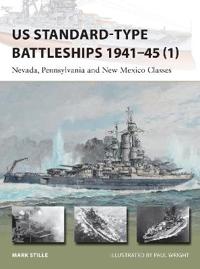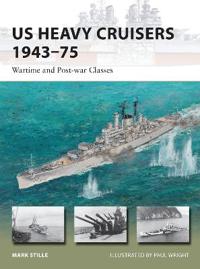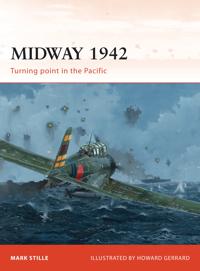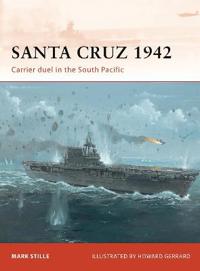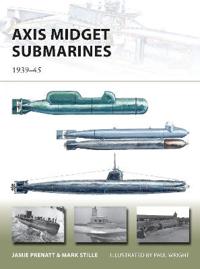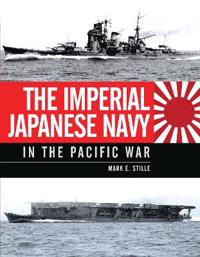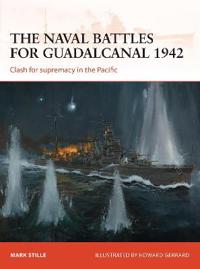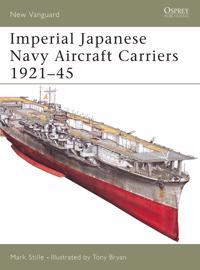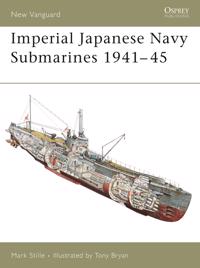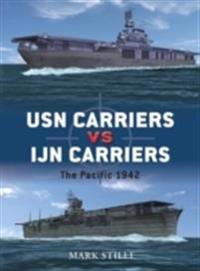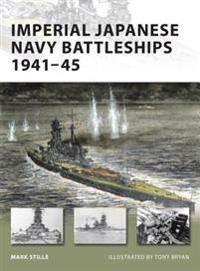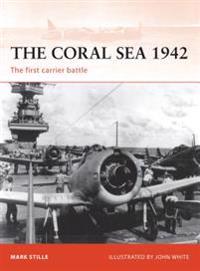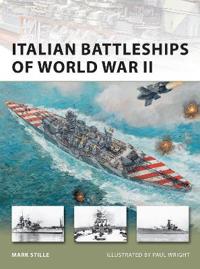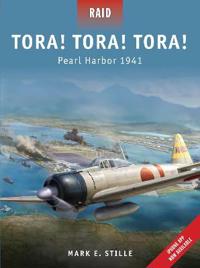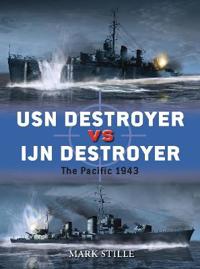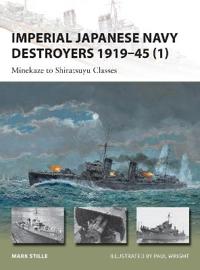US Navy Aircraft Carriers 1922-45 (Pocket)
avStille, Mark
ISBN: 9781841768908 - UTGIVEN: 2005-10-11The USS Langley, the first American aircraft carrier, entered service in 1922. Despite being converted into an aircraft tender, it was the first step in a new direction for the US Navy and naval warfare. This book covers the design, development and operation of USN aircraft carriers built prior to W[...]
US Navy Aircraft Carriers 1939-45 (Pocket)
avStille, Mark
ISBN: 9781846030376 - UTGIVEN: 2007-02-08Dominating the seas during World War II, the US aircraft carrier played a crucial role in every major naval combat of the war.
Development of the "Essex" class began in 1941, and was the largest class of carrier ever built. During the Pacific War it formed the backbone of any fighting force and [...]USN Cruiser Vs IJN Cruiser (Pocket)
avWright, Paul, Stille, Mark, Gerrard, Howard
ISBN: 9781846034664 - UTGIVEN: 2009-09-01Although the war in the Pacific is usually considered a carrier war, it was the cruisers that dominated the early fighting. This thrilling duel presents the cruiser clashes during the crucial battles for Guadacanal in 1942, highlighting the Battle of Savo Island on the August 9 and the Battle of Cap[...]
US Standard-Type Battleships 1941-45 (1) (Pocket)
avMark Stille, Paul (ILT) Wright, Mark Stille
ISBN: 9781472806963 - UTGIVEN: 2015-03Written by US Navy expert Mark Stille, this book offers a unique insight into the Standard-type classes of US battleships. It provides a detailed investigation into the histories of each of the warships in the Standard-type battleship classes, the first three of which, the Nevada, Pennsylvania and N[...]
US Heavy Cruisers 1943-75 (Pocket)
avMark Stille, Paul (ILT) Wright, Mark Stille
ISBN: 9781782006329 - UTGIVEN: 2014-09This title follows on from a companion book covering the US heavy cruisers that were built prior to the war, together forming the definitive guide to the US' heavy cruiser classes. Versatile warships, the heavy cruisers of the Baltimore class, and their successors in the Oregon City and Des Moines c[...]
Midway 1942 (Pocket)
avMark Stille, Howard Gerrard, Mark Stille
ISBN: 9781846035012 - UTGIVEN: 201009In less than one day, the might of the Imperial Japanese Navy was destroyed and four of her great aircraft carriers sank burning into the dark depths of the Pacific. Utilizing the latest research and detailed combat maps, this book tells the dramatic story of the Japanese assault on Midway Island an[...]
Santa Cruz 1942 (Pocket)
avMark Stille, Howard Gerrard, Mark Stille
ISBN: 9781849086059 - UTGIVEN: 201209Despite myth, the Japanese carrier force was not destroyed at Midway but survived to still prove a threat in the Pacific Theater. Nowhere was this clearer than in the battle of Santa Cruz of October 1942. The stalemate on the ground in the Guadalcanal campaign led to the major naval forces of both b[...]
Community, Economic Creativity, and Organization (Häftad)
avMark E. Stille
ISBN: 9780199545506 - UTGIVEN: 200809It has long been an interest of researchers in economics, sociology, organization studies, and economic geography to understand how firms innovate. Most recently, this interest has begun to examine the micro-processes of work and organization that sustain social creativity, emphasizing the learning [...]
Axis Midget Submarines (Pocket)
avJamie Prenatt, Mark Stille, Paul (ILT) Wright
ISBN: 9781472801227 - UTGIVEN: 2014-06During World War II, Germany, Japan, and Italy built approximately 2,000 small, inherently stealthy, naval craft to perform special operations and conventional naval missions. Much more numerous and more technically advanced than their Allied counterparts, they saw service worldwide, operating in th[...]
The Imperial Japanese Navy in the Pacific War (Inbunden)
avMark Stille
ISBN: 9781472801463 - UTGIVEN: 2014-12The Imperial Japanese Navy (IJN) was the third most powerful navy in the world at the start of World War II, and came to dominate the Pacific in the early months of the war. This was a remarkable turnaround for a navy that only began to modernize in 1868, although defeats inflicted on the Russians a[...]
The Naval Battles for Guadalcanal, 1942 (Häftad)
avMark Stille
ISBN: 9781780961545 - UTGIVEN: 201305The battle for Guadalcanal that lasted from August 1942 to February 1943 was the first major American counter offensive against the Japanese in the Pacific. The battle of Savo Island on the night of 9 August 1942, saw the Japanese inflict a sever defeat on the Allied force, driving them away from Gu[...]
Imperial Japanese Navy Aircraft Carriers, 1921-45 (Häftad)
avMark Stille
ISBN: 9781841768533 - UTGIVEN: 200505The Imperial Japanese Navy was a pioneer in naval aviation, having commissioned the world's first built-from-the-keel-up carrier, the 'Hosho'. Throughout the 1920s and 1930s, it experimented with its carriers, perfecting their design and construction. As result, by the time Japan entered World War 2[...]
Imperial Japanese Navy Submarines 1941-45 (Häftad)
avMark Stille
ISBN: 9781846030901 - UTGIVEN: 200706During World War II, the Imperial Japanese Navy was at the forefront of submarine technology. It fielded the largest pre-nuclear submarines in the world, some capable of carrying floatplane bombers, which operated alongside fast combat vessels and midget submarines, all equipped with the best torped[...]
USN Carriers vs Ijn Carriers (Häftad)
avMark Stille
ISBN: 9781846032486 - UTGIVEN: 200711As the Pacific war escalated into the largest naval conflict in history the role of the carrier, the most revolutionary and formidable of all naval weapons, became the linchpin of American and Japanese naval strategy. Finally in 1942, across the huge expanses of the Pacific, these rival carriers fou[...]
Imperial Japanese Navy Battleships 1941-45 (Häftad)
avMark Stille
ISBN: 9781846032806 - UTGIVEN: 200807The Imperial Japanese Navy of World War 2 surpassed the Allied and Axis fleets in innovation and technology. This title covers the 12 Japanese battleships that saw service between 1941-45. Each class is considered in turn in light of its design and construction, its armament and wartime modification[...]
The Coral Sea 1942 (Häftad)
avMark Stille
ISBN: 9781846034404 - UTGIVEN: 200911The Battle of the Coral Sea is unique in the annals of naval history. It is the first battle in which enemy fleets never came within sight of one another. Instead, aircraft launched from carrier decks were sent out to attack the enemy with bombs and torpedoes. In May of 1942, the Japanese fleet move[...]
Italian Battleships of World War II (Häftad)
avMark Stille
ISBN: 9781849083805 - UTGIVEN: 201108"Italian Battleships of World War II".
Tora! Tora! Tora! (Pocket)
avMark E. Stille
ISBN: 9781849085090 - UTGIVEN: 201111"Tora! Tora! Tora!: Pearl Harbor 1941".
USN Destroyer Vs IJN Destroyer (Häftad)
avMark Stille
ISBN: 9781849086233 - UTGIVEN: 201211This book covers the fierce night naval battles fought between the US Navy and the Imperial Japanese Navy during late 1943 as the Allies advanced slowly up the Solomons Islands toward the major Japanese naval base at Rabaul. During this period, several vicious actions were fought featuring the most[...]
Imperial Japanese Navy Destroyers, 1919-45 (Häftad)
avMark Stille
ISBN: 9781849089845 - UTGIVEN: 201303This volume will detail the history, weapons and tactics of the Japanese destroyers built before the war. This includes the famous Fubuki class called Special Type by the Japanese, which were, when completed in the late 1920's, the most powerful class of destroyers in the world. This design forced a[...]




